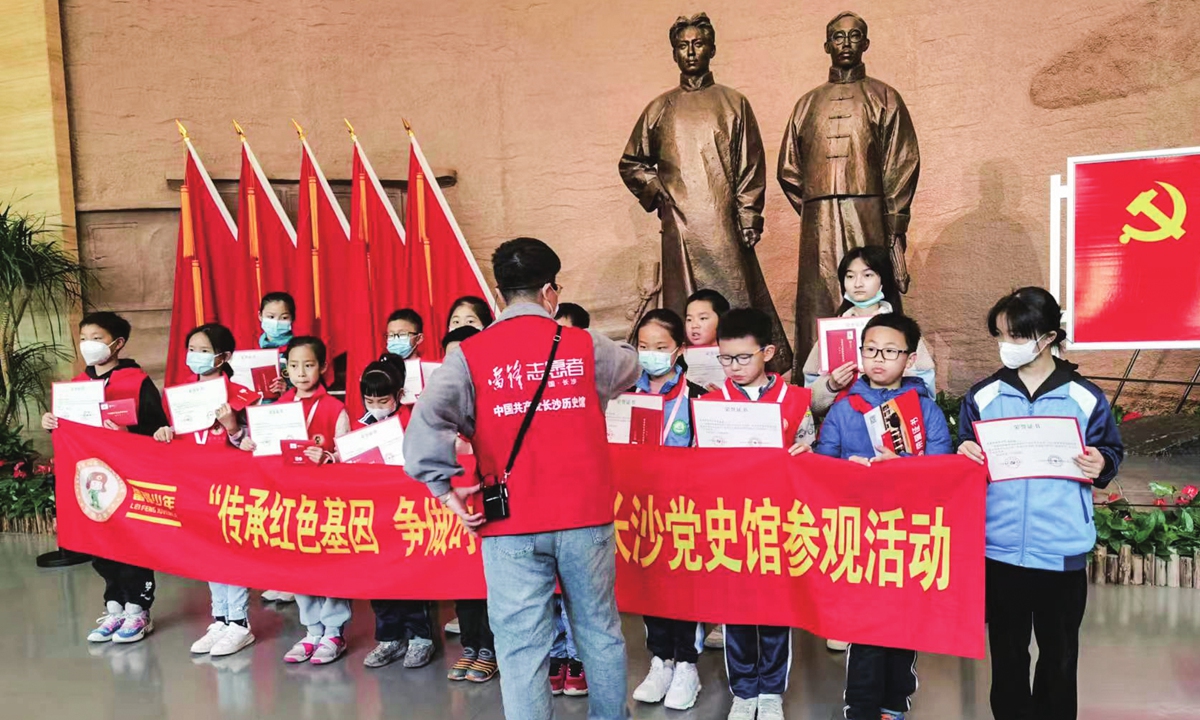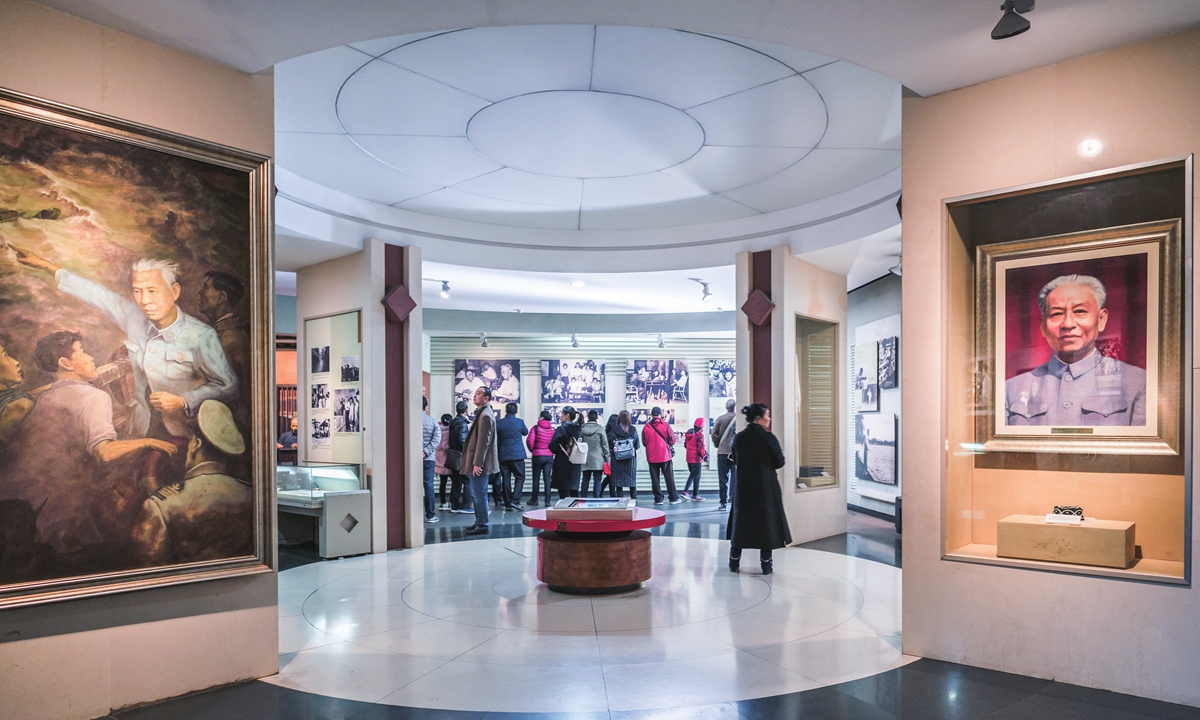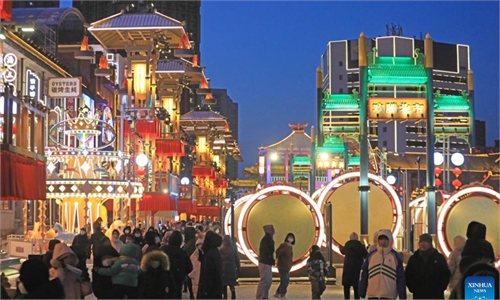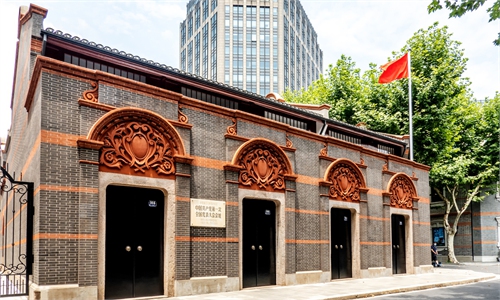ARTS / CULTURE & LEISURE
'Red tourism' becomes increasingly popular among Gen Z

A group of elementary school students take a picture with the statue of Mao Zedong and He Shuheng at the Hunan CPC History Museum in Changsha, Central China's Hunan Province on March 30, 2023. Photo: Xu Yelu/GT

The Liu Shaoqi Memorial Hall in Ningxiang, Hunan Photo: VCG
When one wants to take a photo with the statue of Chairman Mao Zedong in Orange Isle (Juzizhou), one is always surrounded by a diverse crowd and this ignites a sense of pride in one's heart. With the revival of Chinese tourism, more and more tourists have begun to turn their eyes to "red" tourist resorts for learning history.
In the center of Changsha, capital of Central China's Hunan Province, Orange Isle is where Mao Zedong carried out revolutionary activities in his youth. The Mao Zedong Youth Art Sculpture on the Isle is one of China's most attractive and influential "red" scenic spots. The area has become an important window to promote the city's image and a must-visit place in Changsha.
Due to its unique geographical location and rich historical background, Changsha has become a top choice for many young people to visit and "check-in." "Red tourism," as the name implies, includes both patriotic education through reviewing history and leisurely sightseeing. The combination of these two elements gives red tourism its unique charm.
Be it the Yuelu Mountain with its millennium-long academic history, the Orange Isle where young Mao Zedong wrote poetry, or the Tongguan kiln that witnessed the legendary Maritime Silk Road, the unique Hunan culture provides a solid foundation for these attractions, and with the careful integration of culture and tourism, they bring to life diverse and multi-dimensional tourism resources, increasing the popularity of Changsha.
Red tourism is gradually becoming a normalized travel experience. Data from Ctrip shows that in the first half of 2022, 88 percent of tourists booked tickets for local or nearby red tourism attractions. Young people enjoy visiting sites that combine red tourism with national trend culture and creative products, commemorating history in a more fashionable way and expressing patriotic enthusiasm.
At Orange Isle, Global Times reporters met two elderly ladies from South China's Guangxi Zhuang Autonomous Region. "We planned to visit Changsha long ago to experience its history and culture. After the epidemic ended, we booked our flights as soon as we had time. Standing here, we feel very proud," the lady surnamed Liu told the Global Times.
For people born after 1960 and 1970, traveling to red scenic spots is a symbol of honor and a reminder of their youth. But for more young people, "red tourism" is a way for them to learn history, expand their knowledge and shape their way of life. According to the newly released Generation Z Red Tourism Consumption Preference Survey Report in 2021, Generation Z aged between 13 and 27 have become the major participants of red tourism. They prefer red tourism products such as historical sites and relics, revolutionary memorabilia and museums, in-depth tours of old revolutionary areas and performing arts.
At the Hunan CPC History Museum, an 11-year-old volunteer guide surnamed Wang attracted people's attention. According to the museum staff, more than a few thousand visitors come to the museum every day. Therefore, the museum trains a group of guides every year, offering two to three courses a week. After a rigorous selection process and examinations, they can become true volunteers.
Volunteer guides are divided into youth, middle-aged, and elderly groups. "Our training not only includes an introduction to each exhibit in the museum but also offers a more comprehensive and complete review of history. We also constantly update our scripts so that our volunteers can continuously absorb new knowledge," the staff told the Global Times.
Wang came to the museum for training at his mother's recommendation and officially became a volunteer guide in 2022. "In order to give more vivid and accurate explanations, I also read some historical accounts and many other books in my spare time to help me understand the script better. Although I wasn't born in the revolutionary era, I have learned about their stories, which makes me feel prouder of our nation and determined to make more contributions to our country," he said.
Not only are Chinese young people interested in Chinese culture and history, but also foreigners. When two exchange students from Russia showed up at Orange Isle, they quickly become the spotlight. They said they have been in China for three years and have a strong interest in Chinese history. After the pandemic eased, they consulted their Chinese friends about which place best represents Chinese history and culture, and the answer was Changsha.
"We heard that there is a statue of Chairman Mao and places where he lived. We also wanted to understand what makes Chinese people so passionate about their country through these historical and cultural sites," Ivanov said. "This is our third day in Changsha. We have visited many sites related to the CPC, and I think it is their past perseverance, hard work, and bravery that have made China so strong."


